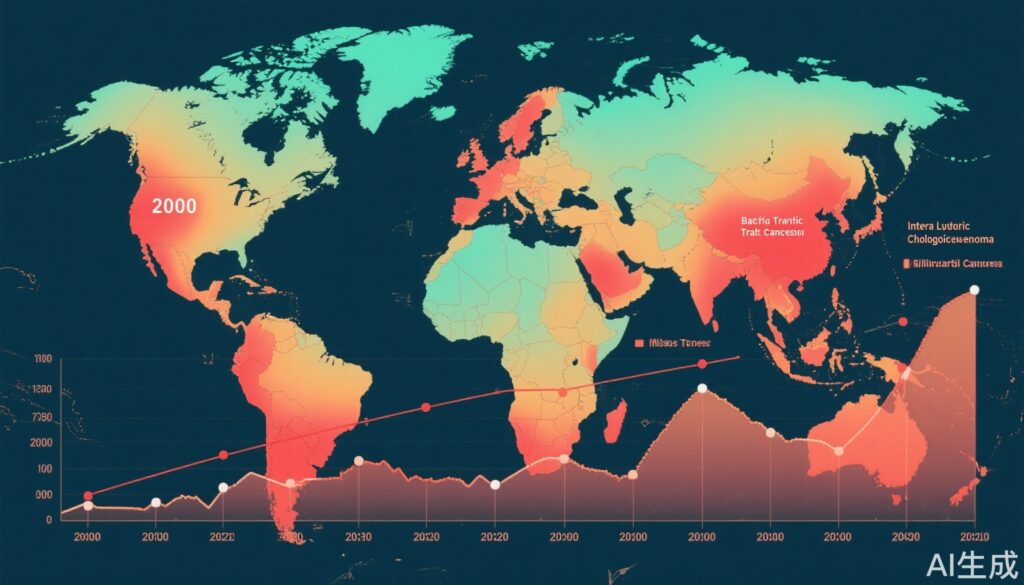Highlight
- Global age-standardized mortality rates (ASRs) from biliary tract cancers (BTCs) remained stable between 2000 and 2022.
- Mortality due to intrahepatic cholangiocarcinoma (iCCA) surged by 120%, while gallbladder cancer mortality declined by 45.5%.
- Western Pacific region exhibits highest BTC-related mortality compared to European and American regions.
- Marked international disparities in mortality trends by BTC subtypes underscore regional variations in risk factors and healthcare access.
Study Background and Disease Burden
Biliary tract cancers (BTCs), encompassing intrahepatic cholangiocarcinoma (iCCA), extrahepatic cholangiocarcinoma, gallbladder cancer, and ampullary cancer, are known for their dismal prognoses and limited therapeutic options. Despite advances in oncology, these malignancies remain challenging to diagnose early and treat effectively. Globally, BTCs contribute a significant burden in terms of morbidity and mortality, yet comprehensive international temporal mortality trend data have been limited. Understanding the evolution of mortality rates worldwide and regionally facilitates targeted public health strategies and guides clinical management pathways. This study aims to fill this gap by analyzing mortality trends over 22 years using the authoritative World Health Organization (WHO) mortality database.
Study Design
This observational study extracted data from the WHO Mortality Database spanning 2000 to 2022. Age-standardized mortality rates (ASRs) per 100,000 population were calculated for BTCs overall, as well as for major subtypes, including iCCA, extrahepatic cholangiocarcinoma, and gallbladder cancer. Locally weighted regression smoothing (LOESS) was applied to generate long-term, smoothed mortality curves at international and regional levels. Additionally, joinpoint regression analysis was conducted on national-level data during 2013–2022 to detect changes and trends in mortality rates for individual countries. This robust epidemiological methodology provided insights into temporal patterns and geographic disparities.
Key Findings
Internationally, the LOESS-smoothed ASR for overall BTC mortality was 2.8 (95% CI: 2.5–3.1) per 100,000 in 2000 and showed negligible change at 2.7 (2.3–3.1) in 2022, indicating an overall stable mortality burden over these two decades. Regionally, mortality rates displayed significant variation: the Western Pacific region had the highest ASR at 4.2 (1.8–6.6) in 2022, substantially greater than the European (2.6 [2.3–2.9]) and American regions (2.2 [1.8–2.6]).
Notably, mortality related to the major BTC subtypes diverged considerably. iCCA mortality nearly doubled, increasing by 120.0% between 2000 and 2022. In stark contrast, gallbladder cancer mortality decreased by 45.5%, while mortality from extrahepatic cholangiocarcinoma remained essentially unchanged. Country-level joinpoint analysis during 2013–2022 unveiled heterogeneous trends, with many countries exhibiting rising iCCA mortality, whereas gallbladder cancer trends were predominantly declining or stable.
These patterns likely reflect differing epidemiological profiles, risk factor distributions—including hepatobiliary parasitic infections, primary sclerosing cholangitis, and viral hepatitis—and disparities in early detection and treatment modalities across regions. The Western Pacific’s elevated BTC mortality may be linked to higher prevalence of certain risk factors like liver flukes (Opisthorchis viverrini) and chronic liver diseases.
Expert Commentary
This comprehensive study provides critical epidemiological insights, highlighting the nuanced nature of BTC mortality trends globally. The pronounced increase in iCCA-related mortality is particularly alarming and may herald a need for reexamining current diagnostic algorithms and risk stratification frameworks. The challenges in early detection—given iCCA’s nonspecific symptomatology and late presentation—underscore an unmet need for validated screening tools, especially in high-incidence areas.
The contrasting decline in gallbladder cancer mortality is encouraging and may reflect improved surgical interventions, enhanced detection of premalignant lesions, and reductions in risk factors such as gallstones and chronic inflammation. However, stable extrahepatic cholangiocarcinoma mortality suggests that advances in treatment have not substantially shifted outcomes, warranting further research.
Limitations include potential variations in coding practices and completeness of mortality data across countries, which might influence comparisons. Nonetheless, the study’s rigorous methods and large dataset confer strength to its conclusions. Integrating findings with molecular and clinical research could enhance mechanistic understanding and identify novel therapeutic targets.
Conclusion
Over the past two decades, international mortality rates for BTCs overall have remained stable; however, a dramatic increase in intrahepatic cholangiocarcinoma mortality demands urgent attention. These findings advocate for development and deployment of effective screening strategies for high-risk populations and optimized management protocols tailored to subtype-specific epidemiology. Policy efforts should prioritize resource allocation for surveillance, prevention, and early intervention, particularly in high-burden regions like the Western Pacific. Future research should focus on elucidating underlying causes for regional disparities and advancing precision oncology approaches for BTCs.
References
Vu QT, Nishimura Y, Harada K, Ito H, Higashionna T, Maruo A, Harada K, Takeda T, Hamano H, Zamami Y, Hagiya H, Koyama T. International trends in biliary tract cancer-related mortality, 2000-2022: An observational study of the World Health Organization Mortality Database. Hepatology. 2025 Sep 1;82(3):626-637. doi: 10.1097/HEP.0000000000001200. Epub 2024 Dec 19. PMID: 39700462.


